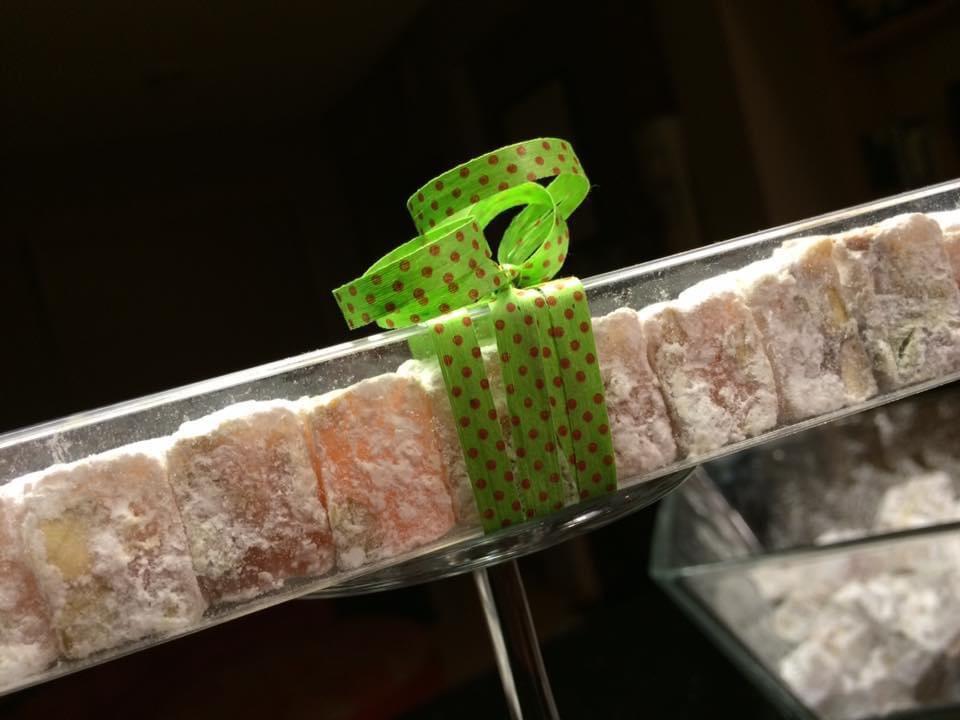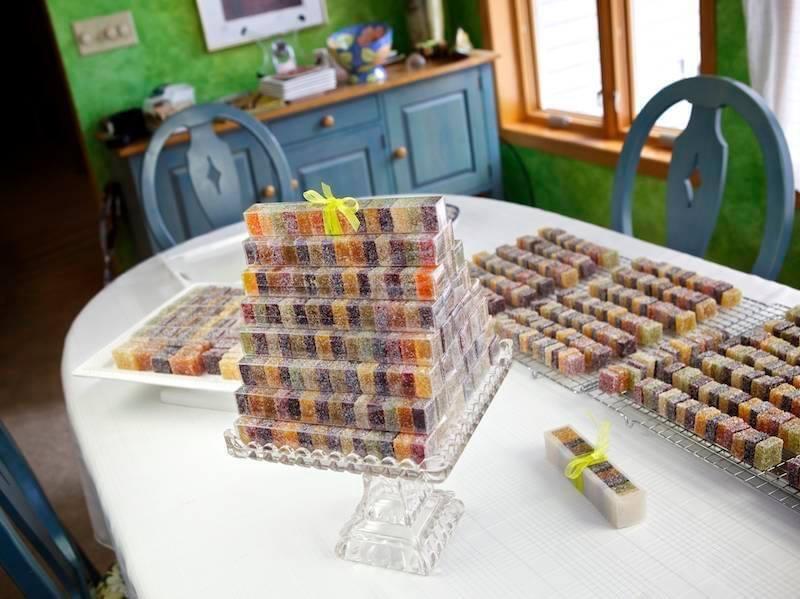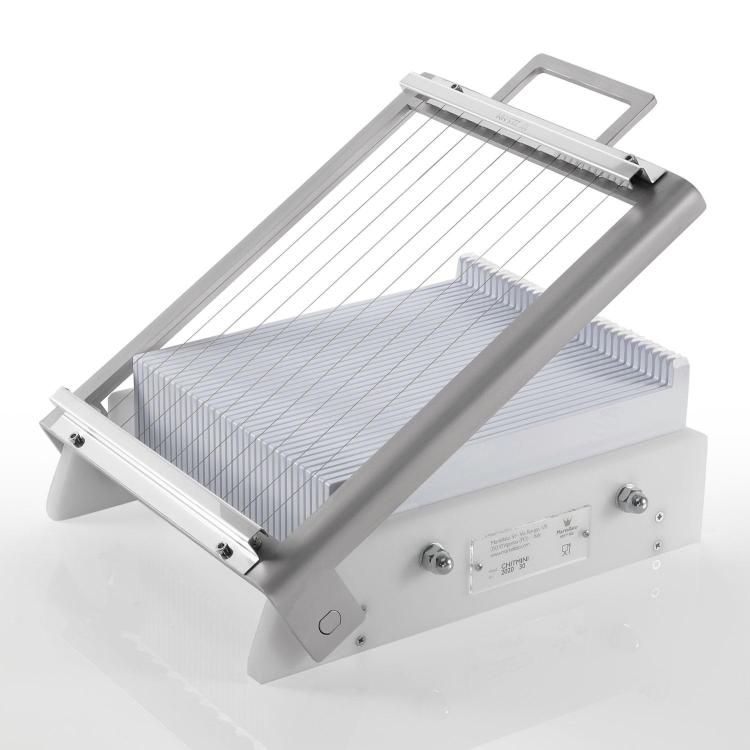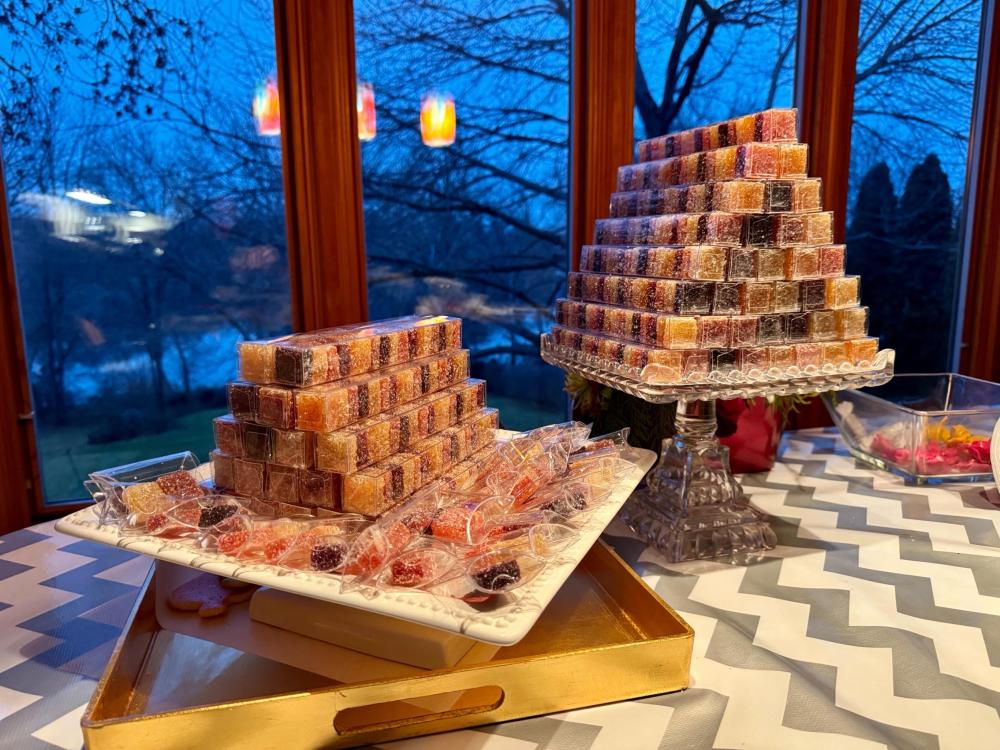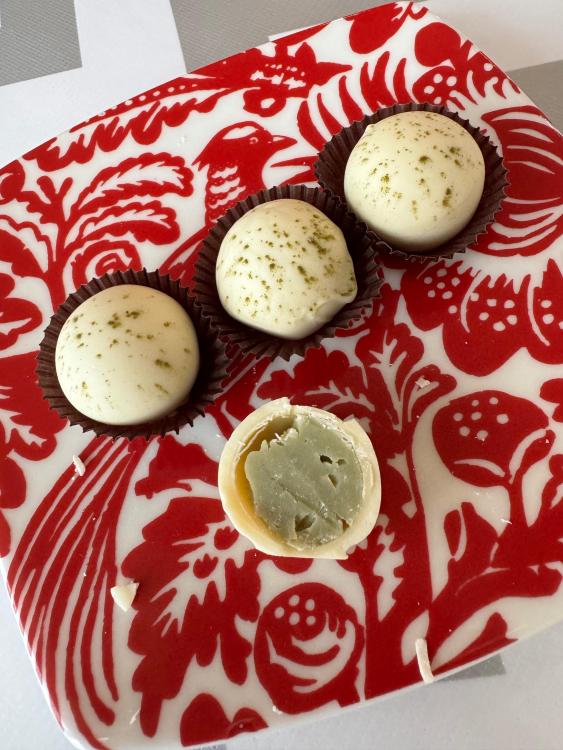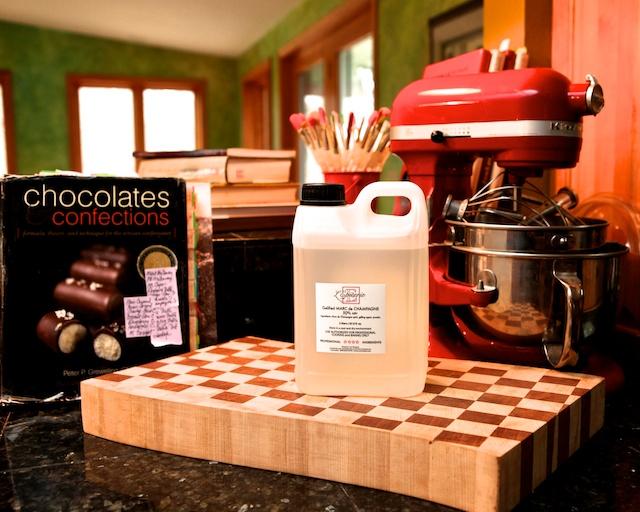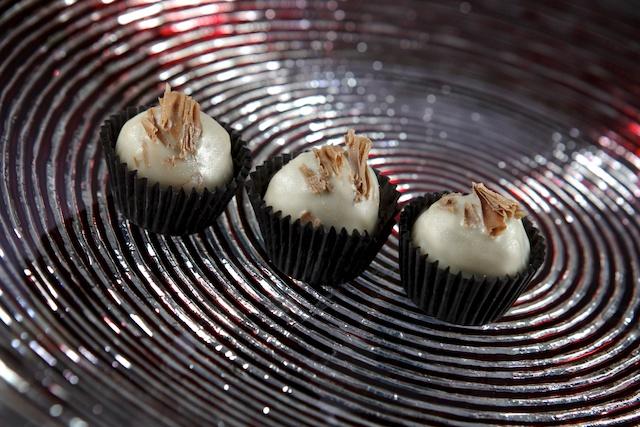-
Posts
43 -
Joined
-
Last visited
Content Type
Profiles
Forums
Store
Help Articles
Everything posted by Elle Bee
-
I love the "Crystal Clear" plastic tubes and pillow boxes from Clearbags for packaging pâtes de fruits. Turkish Delight also looks beautiful in the long tubes. don't have a picture of it, but there's even a tiny pillow box that holds just two pieces of pâtes de fruits—perfect for giving people samples. I love how the long tubes look stacked into a pyramid like this: A tube of Turkish Delight:
-
@Kerry Beal, okay, I think I understand. Tomorrow I will bravely go forth and experiment.
-
Oh I think I get it now. So basically the purpose of the thin layer of hard chocolate on the bottom (as it's being cut) is basically just to keep the slab from sticking to the platform, is that right? And then the wet chocolate on the top later becomes the actual bottom of the truffle when you dip it. Yes?
-
@GRiker, I just checked out that link you shared with the caramel marker and I can see why theirs worked so much better than mine did—they used MUCH better quality parts! All of the parts I used in mine (with the exception of the spacers) were really substandard. Maybe I will try it again now. Thanks for sharing that!
-
Thanks, @Kerry Beal. I understood the first part of your answer, but the second part—about the "chablon on top gets cut when it's still damp"—has me mystified. What am I missing?
-
@GRiker I have some round moulds similar to those that I used to use for making an orange and star anise caramel. I loved the idea of making an orange caramel in a round shape, but I had a hard time making friends with the mould even after giving it several chances. I do still think they're a great idea, even though I don't seem to have the right temperament for them myself. Once the caramel mass is cooked, I just want to get it out of the pot and move on to the next thing. My DIY caramel marker looked a lot like the one in your picture. I made it from a bunch of disassembled pizza cutters that I bought at Target, a piece of threaded steel rod and spacers from Menard's, and a couple of center-drilled dowels for handles that I fitted with threaded inserts. I have a wonderful little centering jig for my drill, so everything was perfectly lined up and I really thought it would work. The problem was that the threaded rod was just not rigid enough to keep from flexing when I pressed on the handles. Finally I realized I had spent more time designing it, building it, and trying to make it work than it would have taken me to just cut the dang caramels in the usual way. I do have a pretty slick method for marking where the cuts go, and I should share that in some thread where it would be on topic. @pastrygirl, oh duh, of course you are right about the soft caramels, and that's a great idea using the wire frame as a marking device. I wasn't even thinking about soft caramels—I tend to make all my caramels on the firmer side (248-250 degrees) and I should definitely have clarified that. Since we're here talking about slabs, though... I wonder if you could answer a question that's been on my mind all day (and causing me to procrastinate about getting started on turning the first of my regular rolled truffle recipes into a slabbed one)... and that question is: When you have a slab of ganache that's been bottomed, the recipes all say to cut it on the guitar with the bottomed side down. But at what point do you do that? I'm guessing somewhere between wet (which would stick to the platform) and fully set up (which seems like it would just crack)? Apologies if this is the stupidest question in the world. 🙄
-
Hi @GRiker, congrats on making your guitar decision. You're going to love having one! To answer your questions: 1. For framing slabs of ganache or meltaways, I would LOVE to have real caramel rulers but have never been able to justify the expense. So instead I use 12 inch lengths of half inch aluminum bar and just arrange them on a sheet of acetate so the opening is either 6x9 or 6x12 (I'm still figuring out the optimal size for my small guitar). I ordered the aluminum bars from OnlineMetals.com years ago, and they've worked very well for me. They are very lightweight, however, so I "glue" them in place on the acetate sheet with untempered melted chocolate before I pour the slab. 2. Yep, hand dipping everything. I use the Revolation 2 chocolate tempering machine. It's small, but adequate for my purposes—it holds about a pound and a half of chocolate and I can dip about 60 truffles before I have to start over with a fresh batch of chocolate. My only real complaint about it is that it is SO LOUD. I actually built a box out of dense insulation sheet one year to damp the noise. Which worked surprisingly well, but was a different kind of annoyance. So now I just wear ear plugs when I use it. 3A. I painstakingly mark and cut all my caramel by hand into 3/4" x 1" rectangles. The next piece of serious confectionery equipment for me is going to be a caramel marker with changeable spacers. I actually tried making one of these once, but it flexed too much to be useful. I'm fussy about the size because sometimes I like wrapping them in colored foils like tiny Christmas presents and put them in candy cups so I can pack them neatly in the same boxes I use for chocolates. Obsessive, I know, but they're so pretty that way. When I do this I listen to the best caramel wrapping theme song of all time: "I Wanna be Sedated" by the Ramones. 🤪 3B. Please do not even consider using your guitar to cut caramel. It will make you very sad. If you're lucky, you will only end up with broken wires. If you are unlucky, you could seriously damage the guitar. And probably ruin a lot of delicious caramel in the process.
-
I've been thinking for a couple of years already that I should share a review of my guitar in case it's helpful to anyone else here. One of my New Year's resolutions is to be better at giving back to a couple of wonderful communities (like this one) where I have gained invaluable information by lurking without getting around to posting much myself. So here goes: I'm a hobbyist confectioner who makes 15-20 pounds of pâtes de fruits, several kinds of meltaways, hundreds of truffles, a thousand or so caramels, and at least one giant sheet of nougat... during an annual month-long frenzy every holiday season. And pretty much not at all during the rest of the year. The first year I made pâtes de fruits, I made 11 flavors in 12x12 inch frames, and cut all of them into 22mm squares by hand. After which I said I would never make pâtes de fruits again unless my fairy godmother somehow magically provided me with a guitar because I would never be able to afford to buy one. That was maybe 12 years ago. Two moves, a few major life changes, and one excellent relationship later... I was sharing photos of my massive one-time pâtes de fruits extravaganza with my best beloved in advance of our first Christmas together, when he said (being at the time a complete innocent with respect to all confectionery-related complexities), "You should do that for the holidays this year—the grandkids would love it!" Whereupon I explained the cutting problem, and how real confectioners have these amazing tools called "guitars," at which point I did a google search to show him a picture of what I was talking about... and discovered to my surprise that Martellato had developed a mini one. Two weeks later, this was delivered as my early Christmas present that year: It's this one: https://www.martellato.com/product/mini-22mm-easy-system-guitar.html I've had it for about 6 years now and I love it. Sometimes I think it might be nice to have the double one instead, but that's usually only on the occasions when I get distracted and forget to raise the frame until after I've already turned the slab. Which happens maybe once a year on average. And since I like to cut everything in squares, and all the squares are the same size, the single frame is really ideal for me. While my confectionery activities are seasonal, the quantity of products that I churn out during that limited time is significant and I pretty much do all of it by myself. This guitar has been an enormous time saver for me. When I cut all those pâtes de fruits by hand that first year, it took me three days to get it done. This year I timed myself cutting them on the guitar—I had seven flavors in 12x12 slabs and it took me less than an hour to do all of it. And that includes the sugaring. One thing I would recommend to anyone who may be interested in a smaller size guitar like this one is to give some consideration to the size of the platform vs. the size of the slabs you will be cutting. That seems really obvious on the surface, and yet I ended up being surprised by how much trial and error it took for me to figure out the most efficient slab dimensions for using the guitar without wasting more product than necessary. That being said, I've just recently started the process of converting all my piped/rolled truffle recipes to slabbed ones so it's possible I'm more obsessed with this issue at the moment than I really need to be... or will ever be again. 😂 Oh and a related thing worth mentioning is that, while it can cut a 9x9 inch slab of pâte de fruit (which covers the entire platform), it has a substantially easier time cutting a 9x6 inch slab. I'm risk averse about things like breaking the wires, so I choose to be cautious. What I do with my 12x12 inch slabs of pâtes de fruits is simply cut them in half and then cut 3" off the end—this gives me two 6x9 inch slabs, and two 6x3 inch slabs. I cut the 6x9 ones, and then I put the two smaller ones side by side on the guitar arranged so that a wire will go between them. As for maintenance... I haven't had to do any. It does come with extra wires, and various tools for replacing and tightening them, but so far I haven't had any need to learn how to do any of that. Cleaning this guitar isn't difficult, but I don't think it's like cleaning most other guitars. The frame can go in the dishwasher, but the platform can't. To clean the platform thoroughly, you unscrew the acorn nuts (there are two on each side) and pull out the threaded rods. This releases the platform... which (very surprisingly unless you're prepared for it, which I was not) turns out to be about 3 dozen separate, indentical flat pieces. Mine is currently all apart, drying next to the sink in my candy kitchen, and I can go take a picture of it if anyone wants to see what the deconstructed guitar looks like. It was a little unnerving the first time I disassembled it, but now I'm used to it. It's actually very simple to clean, and a piece of cake to reassemble in just a couple of minutes. Bottom line: For a confectioner like me, who just has one massive push to get a lot done in a short time once a year, this thing is a godsend. It would also be ideal for someone who does smaller amounts of confectionery on a regular basis. For a professional confectioner with a busy retail operation, on the other hand, I think it would likely be frustratingly inefficient. it's perfect for me, though. And just one of many reasons why my best beloved deserves to have all the candy he could possible wish for. What an amazing gift! ❤️
-
I made seven flavors of pâtes de fruits for the holidays: Morello cherry, guava, pineapple, Williams pear, blood orange, passion fruit, and cassis. All made with Ravifruit purees except for the Cassis, which was Boiron. I used the old version of the Boiron formulas, scaled to fit my 12x12 removable bottom cake pans. Although they all turned out well (good texture, everybody loved them), I was disappointed in the flavor of the passion fruit and blood orange ones. Some back story before I get to my actual question: In years past, I've ordered my purees from Perfect Puree of Napa Valley. Every puree I've had from them has been great (except maybe the carmelized pineapple, which is a little... odd). I especially love their concentrated passion fruit and blood orange purees for delicious, intensely flavored PdFs. My sole complaint about Perfect Puree over the years has been their ridiculously astronomical shipping costs. This year I decided I'd had enough aggravation about that for one lifetime and so I chose to order purees from l'Epicerie instead. [EDITED TO ADD: Wait... did I say l'Epicerie??? Sheesh. I must have been really tired when I wrote this post. 😂 I don't think l'Epicerie even sells fruit purees! (Although they do have a lot of other great stuff, and are my usual source for PdF pectin). Anyway, I ordered these frozen fruit purees from Gourmet Foodstore. Which has a great selection, reasonable shipping prices, and prompt delivery, as I stated below. I will definitely be ordering from them again. Sorry for the error.] Quality products, shipped fast at a reasonable cost—I'm a happy l'Epicerie Gourmet Foodstore customer. I knew Boiron made a concentrated blood orange puree and that's what I planned to order. Unfortunately it was out of stock so I opted for Ravifruit's unconcentrated one and proceeded to improvise. In their formula for blood orange PdF (which uses a pear "basis puree"), Boiron has a footnote recommending that 10% of the blood orange puree called for in the recipe be in the form of concentrate. My scaled down version of the formula called for 580g of blood orange puree. 10% of that weight is (roughly) 60g, so I weighed out 520g of the unconcentrated puree to use as is, and then "made" a concentrate by reducing 180g of the unconcentrated puree to 60g. I did this in the microwave with the intention that the reduction would taste less "cooked." The end result was that my concentrated puree tasted... okay. Not terrible, certainly more intense than the unconcentrated puree, but definitely not the bright, tart/sweet, intensely fruity flavor of Perfect Puree's blood orange concentrate. With a much duller color. The blood orange PdFs I made with it were also... okay. Pleasant enough, identifiably orange-y, but with no real "punch," so pretty boring. The question is: in the absence of the Boiron (or some other commercially prepared) concentrate), is there anything I could have done differently to achieve a better outcome? Would it have worked to use 100% blood orange puree instead of using the basis puree? I suppose it's idle speculation at this point since I simply won't do it again without a proper concentrate available, but I'm curious nonetheless. In the meantime, here's a gratuitous photo of my 6-year-old granddaughter who loves nothing better than to help me pack pâtes de fruits and wrap caramels, and is very serious about having scrupulously clean hands when she does so.
-
Every holiday season I try to come up with one experimental truffle recipe for future development. Usually the experiment will be "good enough" that I let people try them. Sometimes it's actually great and ends up in the regular rotation with no additional tweaking. But every once in a while... it's a spectacular failure. This year my experiment was a Matcha Truffle. Which I am now calling the "Miss Havisham Truffle," because, like the vengeful jilted spinster from "Great Expectations," this truffle is cloyingly sweet, with an overwhelmingly bitter bite. Purely two-dimensional, very unpleasant to experience, an unfulfilled hollow shell of a creature. In short, this truffle has a serious personality disorder. On top of which, it looks like it got dressed half a century ago. Epilogue: No one is getting these. Back to the drawing board. I rather enjoy this kind of failure and (since I do actually like matcha) am already thinking about how I might turn it around. For one thing, I will use a better grade of matcha—one that I'm willing to drink. Maybe also add something to make the flavor profile more interesting, possibly citrus... like maybe an orange liqueur???.... is that a crazy idea? And while I will still use white chocolate for the ganache because I love the idea of a green center, dipping them in white chocolate (I used Valrhona Opalys) was a huge overly sweet mistake. I'm thinking a semisweet might be the best bet—what do you guys think? I have a block of Callebaut 811 and could use that. EDITED TO ADD: Also I think I am done trying to work with hollow shells. No matter how fluid my ganache is, it's always a fiddly, super annoying PITA to make sure I've filled them completely... and even when I'm "pretty sure," like I was here, there are still always some with gaps. Actually, I just had an idea: I made 30 of these for my test batch, and since NO ONE is going to eat any of them, it seems like a great opportunity for some data collection. I'm going to cut all of them open and find out what percentage of them have gaps. Guessing it will be a high number.
-
Late to this thread, but I'll add this information anyway, in hopes that it may save others the kind of endless researching I found myself doing a few months ago: Another source for the elusive Marc de Champagne is l'Epicerie. This is a gellified product, like what Steve mentioned above. I suppose gellification is what enables it to be offered for sale in interstate commerce without violating about 5,000 alcoholic beverage regulations. Anyway, l'Epicerie offers it in two sizes. Since there's no pictures provided on the product page, I took one - this is the 2 liter (small) size: For those who aren't familiar with it, Marc de Champagne is a brandy distilled from the pomace of Champagne grapes after pressing. There seems to be only one distillery that makes it - owned by the Goyard family in France - and they purchase virtually all of the pomace produced by the Champagne region's wineries and use it for making Marc de Champagne. As you can imagine, annual production is fairly low. Presumably, much of it is used to make the gellified version of the product. I spent DAYS looking everywhere online for a liquor store anywhere in the U.S. that carried the real thing. That search was absolutely fruitless, and I finally concluded that it's just not available here. Which would make sense, considering that the only people who might want it seem to be serious confectioners. Even if we were a large enough community to justify importing it to the U.S., the headache of distributing single bottles around the country in compliance with all the state liquor laws would be enough to make anyone want to throw themselves off the nearest parapet. So, for us, the gellified version is the only version. Hold that thought while we talk about truffles for a minute.... Champagne truffles, as Wybauw points out, are not made with Champagne because it must be boiled to kill the yeast and boiling destroys the flavor. Marc de Champage does not have this drawback - like any other spirit, it may simply be incorporated into the ganache directly from the bottle. Moreover, since its alcohol content is 60% by volume, Marc de Champagne contributes far less available water to the formulation than a wine like Champagne would. But here's the thing... Marc de Champagne, being a brandy, ISN'T Champagne, nor does it taste particularly like Champagne. When we use it to make truffles, we are REALLY just making brandy truffles that happen to permit the proper and legal use of the "Champagne" appellation to identify them. And while ANY brandy or grappa with a similar flavor profile would produce exactly the same truffle, much (if not all) of the romance of a "Champagne Truffle" seems to come from the name. Which is why I searched high and low for Marc de Champagne, and finally settled for the gellified stuff, when I had a perfectly delicious - and locally produced! - grappa that I would have preferred to use instead. Incidentally, I don't really adore Champagne truffles all that much myself, but other people do... so I make them. My chief interest in them comes from the opportunity to experiment endlessly with ways to keep the pop rocks "alive" longer. And now back to the product itself.... Brandies (including Marc de Champagne) and eaux de vie in regular bottled form are typically 60% alcohol by volume, the remainder being water. If you want to determine the amount of water these products add to a ganache formulation, it is possible to make that calculation using basic math - that is, it's possible to do it in a way resulting in an answer that is sufficiently in the ballpark to be reasonably reliable. Gellified Marc de Champagne, by contrast, is 50% ABV, and contains (according to the label) "Marc de Champagne spirit, quassia, gelling agent." That's quite confusing, since quassia IS a gelling agent. I suspect the ONLY additive is quassia, and that the label is just very badly written. Whether that's the case or not, the bigger issue is that the quantities are unspecified. Accordingly, it is extremely difficult - perhaps impossible - for anyone (not a lab) to calculate the water content. Moreover, there seems to be absolutely no guidance anywhere for reliably substituting these products for the real thing. Add to all that the headache of trying to rework Wybauw's recipe into something that could be rolled and hand dipped, and... well, let's just say my usually sweet disposition was challenged for several days running. In the end I came up with a formulation that was acceptably tasty, if VERY insufficiently creamy (probably due to overestimating the water content, underestimating the effects of the gelling agent, and overcompensating with added cocoa butter), and with a shelf life in excess of three weeks. I'm still working on it. I definitely agree with the findings of the previous posters who would increase the amount of flavoring called for in the recipe. Here's what the last batch looked like: I hope this of use to somebody. And if anyone has more information on using these gellified products, I'd love to hear it.
-
No doubt Hershey's didn't want the SharffenBerger brand competing with Hershey's "gourmet" line of chocolate products. As if. This is so disappointing. SB has pretty much been the ONLY reliable chocolate available for purchase in my town (without ordering online, I mean). Sigh.
-

Cooking with "Chocolates and Confections" by Peter Greweling (Part 2)
Elle Bee replied to a topic in Pastry & Baking
Ah! It's a communications issue! I will go clarify my intent to the surly slab and report back (mutters to self,"I am the boss of my confections, I am the boss of my confections, I am the boss...") Thanks for the tip! Edited to add... HA! That worked a treat!!!! (considering changing user name to Elle BOSS....) PS - I actually considered posting my question as a reply in that original meltaway thread, and then wasn't sure, since all the "conversation" there took place pretty much at the same time. I dithered back and forth on whether to post there or here -- would it have been preferable to put it with the previous discussion? (sorry if I screwed up.... ) -

Cooking with "Chocolates and Confections" by Peter Greweling (Part 2)
Elle Bee replied to a topic in Pastry & Baking
Mint Meltaway Weirdness... OK, so there's been some strange chocolate behavior on MY planet, and I'm wondering if this happens on any of YOUR planets.... First batch of Mint Meltaways from the Greweling book (one quarter recipe) turned out GREAT. Second batch (half recipe) melted just like the first, set up more slowly, and then crystallized in a way I've never seen -- like little tiny BB's of chocolate suspended in a solid (but more melty) chocolate/coconut base. Both the chocolate and coconut oil were fully melted when I combined them. The only difference in handling between the first and second batches is that I didn't try tabling the second batch -- I did try it with the first batch, but it was so fluid I ended up scraping it all back into the bowl, stirring until cool, and then pouring it into the pan. Any clues as to what's going on? Meanwhile, as there was nothing to lose, I decided to experiment a bit. Remelted about a fourth of the set up mixture, added a cup of warm heavy cream, cooled it over some ice, and put it in my cream siphon. Then heated a mug of milk until hot, and gave it nice big swirl of aerated mint meltaway/cream mixture on top. That was tasty -- way too rich, but no regrets... :-) I will try turning the rest of the batch back into what it was originally meant to be. Or maybe I'll do something else. Or maybe I will throw it out. Comments and ideas welcome. -
I tried the Clayton recipe several years ago. Not bad bread, but not Bauernbrot (or, at any rate, not what I remembered as Bauernbrot). So sad...
-

Cooking with "Chocolates and Confections" by Peter Greweling (Part 2)
Elle Bee replied to a topic in Pastry & Baking
Hello everyone, newbie here. There's a recipe for "Food Processor Poured Fondant" in The Cake Bible by Rose Beranbaum. Other than glazing petits fours, I've only used it to make the centers for chocolate covered cherries (which everyone in my family loves except me - I'm a caramel and nougat junkie myself). Just got Greweling's book about a week ago, and am eager to try the food processor method with his fondant. Meanwhile, here's the Rose recipe: 500g sugar 118g water 82g corn syrup Cook to 238F. Immediately pour into food processor bowl, insert a clean thermometer, allow it to cool (uncovered) to 140F, add flavorings, process a couple of minutes until it's opaque, pour it into a sealable container, cool completely, seal it so it's airtight, and let it rest at room temp for 24 hours. To use, heat the fondant over a water bath, and thin it to the required consistency with a warm stock syrup (i.e., 30% - 1 part water to 2 parts sugar by volume). ← Welcome Elle Bee - always happy to have another caramel and nougat junkie here on eG. That looks like a really nice and easy way to make fondant. Even better than using a mixer I'd say. I'll have to give it a try. Thanks for posting it. ← Thanks, Kerry! Rather in awe of everybody's knowledge here, so I'm happy to offer something from my own comfort zone (cake/cookies) that may prove useful to any of you candy mavens. Meanwhile, I cautiously ventured into Greweling Land today with a quarter batch of Mint Meltaways (you know, sort of like putting one toe in the water first...). Used about 2/3 70% dark and 1/3 milk chocolate, with about 7 drops peppermint oil. They set up nicely, good flavor -- discernably minty, but not overwhelmingly minty. VERY melty, and just as soon as I finish my hot cocoa with Frangelico whipped cream*, I intend to enrobe them in some shiny dark chocolate (less messy than the confectioner's sugar Chef G. shows in the book). *Took your advice from some other thread and bought an iSi cream siphon today. Yum - thanks for that tip! (Note to self: if you can't stay away from the whipped cream, fine. Just stop spiking it with alcohol before you put it in the siphon...) -
Anne, I will be watching this thread with great anticipation! I've been craving this very bread myself for about 30 years -- after living for a time in Germany and Austria, where there's a sausage vendor on just about every street corner, ALL serving their wares with the same delicious Bauernbrot. The only time I've ever found it anywhere in the U.S. was in 1991 in Los Angeles at Eureka!, Wolfgang Puck's short-lived restaurant/brewery. Fabulous charcuterie there, too. Unfortunately the brewery operations were a financial disaster, and the place was forced to liquidate several months later. After all these years, it's still the greatest disappointment of my foodie life that I was never able to eat there a second time. I know, I know, it's just bread and sausage (ah, but SUCH bread and sausage!!!) Anyway, I love to bake bread, but am too impatient to fiddle over the recipes (although I will fiddle endlessly with recipes for sweets). So please, please, please keep us posted! Edited to add: So now that I'm fixated on the possibility of consuming Bauernbrot again in this lifetime, I've just impulsively ordered this cookbook (for a whopping $0.46!!! from an Amazon reseller), in hopes that perhaps Mr. Puck chose the share the thing I loved most from poor Eureka!... Laurie
-

Cooking with "Chocolates and Confections" by Peter Greweling (Part 2)
Elle Bee replied to a topic in Pastry & Baking
Hello everyone, newbie here. There's a recipe for "Food Processor Poured Fondant" in The Cake Bible by Rose Beranbaum. Other than glazing petits fours, I've only used it to make the centers for chocolate covered cherries (which everyone in my family loves except me - I'm a caramel and nougat junkie myself). Just got Greweling's book about a week ago, and am eager to try the food processor method with his fondant. Meanwhile, here's the Rose recipe: 500g sugar 118g water 82g corn syrup Cook to 238F. Immediately pour into food processor bowl, insert a clean thermometer, allow it to cool (uncovered) to 140F, add flavorings, process a couple of minutes until it's opaque, pour it into a sealable container, cool completely, seal it so it's airtight, and let it rest at room temp for 24 hours. To use, heat the fondant over a water bath, and thin it to the required consistency with a warm stock syrup (i.e., 30% - 1 part water to 2 parts sugar by volume).



